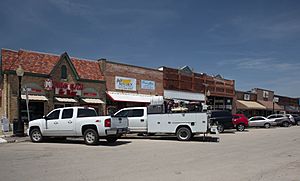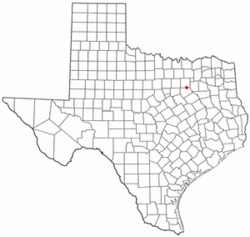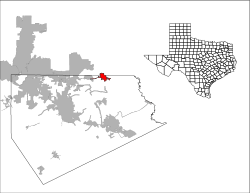Ferris, Texas facts for kids
Quick facts for kids
Ferris, Texas
|
|
|---|---|

Downtown Ferris, Texas
|
|

Location of Ferris, Texas
|
|
 |
|
| Country | United States |
| State | Texas |
| Counties | Ellis, Dallas |
| Area | |
| • Total | 4.78 sq mi (12.37 km2) |
| • Land | 4.63 sq mi (12.01 km2) |
| • Water | 0.14 sq mi (0.37 km2) |
| Elevation | 456 ft (139 m) |
| Population
(2020)
|
|
| • Total | 2,788 |
| • Density | 583.3/sq mi (225.38/km2) |
| Time zone | UTC-6 (Central (CST)) |
| • Summer (DST) | UTC-5 (CDT) |
| ZIP code |
75125
|
| Area code(s) | 214, 469, 945, 972 |
| FIPS code | 48-25752 |
| GNIS feature ID | 2410500 |
Ferris is a city located in the state of Texas, USA. It is found in both Dallas and Ellis counties. Ferris is about 20 miles (32 km) south of downtown Dallas. In 2020, about 2,788 people lived there.
Contents
Discovering Ferris: A Look at Its Past
The area where Ferris is today began to be settled in the early 1870s. On September 28, 1874, a local family gave about 100 acres (0.40 km²) of land to four people. This land was meant for building a new town and a railway station.
The person who helped with this land deal was Judge Justus Wesley Ferris. He was from Waxahachie. The new community was named after him. Within ten years, Ferris had grown quite a bit. It had about 300 people, a post office, places to grind grain, cotton gins, four churches, and a school.
On September 18, 1882, the people of Ferris voted to make their community an official town. Out of 47 votes, 34 people (72%) voted yes, and 13 people (28%) voted no. The results were confirmed on September 30, and Ferris officially became a town. By 1900, the town had 904 residents. This number grew to 1,233 residents by 1910.
By 1914, Ferris had 50 businesses. Six of these were brick plants, which used the rich soil in the area. The population grew to 1,586 by 1925. However, it went down during the 1930s and 1940s. This was because of the Great Depression and World War II.
Ferris did very well in the years right after the war. Four brick plants were working in the 1950s. The community became known as the "Brick Capital of the Nation." Ferris also has another nickname, "The City that Bricked the World," which people still use today. In 1952, the population was 1,734. By 1964, it reached 1,807. Every year, at the end of April, Ferris holds its Annual Brick Festival.
The growth of the Dallas–Fort Worth Metropolitan Area helped Ferris grow. Also, the building of Interstate 45 in the late 1900s helped a lot. Even though the number of businesses went down in the 1980s, the population kept growing. It was 2,212 in 1990, 2,175 in 2000, and 2,436 in 2010. In 1994, the Ferris men's basketball team won the 3-A State Championship.
Geography and Climate of Ferris
Ferris covers a total area of about 4.78 square miles (12.4 square kilometers). Most of this area is land, about 4.63 square miles (12.0 square kilometers). A small part, about 0.14 square miles (0.4 square kilometers), is water. Most of Ferris is in Ellis County, with a small part in Dallas County.
Understanding Ferris's Climate
Ferris has a humid subtropical climate. This means it has hot, humid summers and mild winters. The hottest temperature ever recorded in Ferris was 112°F (44°C) on July 18 or 20, 2022. The coldest temperature recorded was -1°F (-18°C) on December 22, 1989, and again on February 15–16, 2021.
| Climate data for Ferris, Texas, 1991–2020 normals, extremes 1962–present | |||||||||||||
|---|---|---|---|---|---|---|---|---|---|---|---|---|---|
| Month | Jan | Feb | Mar | Apr | May | Jun | Jul | Aug | Sep | Oct | Nov | Dec | Year |
| Record high °F (°C) | 84 (29) |
96 (36) |
94 (34) |
100 (38) |
102 (39) |
110 (43) |
112 (44) |
111 (44) |
111 (44) |
99 (37) |
92 (33) |
87 (31) |
112 (44) |
| Mean maximum °F (°C) | 76.4 (24.7) |
80.8 (27.1) |
84.2 (29.0) |
88.3 (31.3) |
93.2 (34.0) |
97.8 (36.6) |
103.0 (39.4) |
103.8 (39.9) |
99.2 (37.3) |
92.8 (33.8) |
83.0 (28.3) |
77.6 (25.3) |
104.8 (40.4) |
| Mean daily maximum °F (°C) | 57.5 (14.2) |
61.7 (16.5) |
69.0 (20.6) |
76.6 (24.8) |
83.8 (28.8) |
91.5 (33.1) |
95.9 (35.5) |
96.5 (35.8) |
90.0 (32.2) |
79.5 (26.4) |
67.2 (19.6) |
58.7 (14.8) |
77.3 (25.2) |
| Daily mean °F (°C) | 46.5 (8.1) |
50.3 (10.2) |
57.2 (14.0) |
65.0 (18.3) |
73.5 (23.1) |
81.1 (27.3) |
84.7 (29.3) |
84.9 (29.4) |
78.1 (25.6) |
67.2 (19.6) |
55.9 (13.3) |
47.8 (8.8) |
66.0 (18.9) |
| Mean daily minimum °F (°C) | 35.6 (2.0) |
38.8 (3.8) |
45.4 (7.4) |
53.3 (11.8) |
63.2 (17.3) |
70.7 (21.5) |
73.5 (23.1) |
73.3 (22.9) |
66.2 (19.0) |
55.0 (12.8) |
44.6 (7.0) |
36.8 (2.7) |
54.7 (12.6) |
| Mean minimum °F (°C) | 20.8 (−6.2) |
24.9 (−3.9) |
28.4 (−2.0) |
38.5 (3.6) |
48.4 (9.1) |
61.1 (16.2) |
67.2 (19.6) |
66.4 (19.1) |
53.4 (11.9) |
38.5 (3.6) |
27.7 (−2.4) |
22.9 (−5.1) |
17.6 (−8.0) |
| Record low °F (°C) | 3 (−16) |
−1 (−18) |
14 (−10) |
29 (−2) |
38 (3) |
53 (12) |
55 (13) |
50 (10) |
42 (6) |
26 (−3) |
16 (−9) |
−1 (−18) |
−1 (−18) |
| Average precipitation inches (mm) | 2.96 (75) |
3.08 (78) |
4.00 (102) |
3.85 (98) |
4.34 (110) |
3.95 (100) |
1.98 (50) |
2.81 (71) |
2.69 (68) |
4.86 (123) |
2.84 (72) |
3.51 (89) |
40.87 (1,036) |
| Average snowfall inches (cm) | 0.1 (0.25) |
0.2 (0.51) |
0.0 (0.0) |
0.0 (0.0) |
0.0 (0.0) |
0.0 (0.0) |
0.0 (0.0) |
0.0 (0.0) |
0.0 (0.0) |
0.0 (0.0) |
0.1 (0.25) |
0.1 (0.25) |
0.5 (1.26) |
| Average precipitation days (≥ 0.01 in) | 5.6 | 5.8 | 6.3 | 5.5 | 6.6 | 5.1 | 3.5 | 4.3 | 4.3 | 5.5 | 4.9 | 5.3 | 62.7 |
| Average snowy days (≥ 0.1 in) | 0.1 | 0.2 | 0.0 | 0.0 | 0.0 | 0.0 | 0.0 | 0.0 | 0.0 | 0.0 | 0.1 | 0.1 | 0.5 |
| Source 1: NOAA | |||||||||||||
| Source 2: National Weather Service | |||||||||||||
People of Ferris: Demographics
| Historical population | |||
|---|---|---|---|
| Census | Pop. | %± | |
| 1880 | 106 | — | |
| 1890 | 311 | 193.4% | |
| 1900 | 904 | 190.7% | |
| 1910 | 1,233 | 36.4% | |
| 1920 | 1,586 | 28.6% | |
| 1930 | 1,438 | −9.3% | |
| 1940 | 1,436 | −0.1% | |
| 1950 | 1,735 | 20.8% | |
| 1960 | 1,807 | 4.1% | |
| 1970 | 2,155 | 19.3% | |
| 1980 | 2,228 | 3.4% | |
| 1990 | 2,212 | −0.7% | |
| 2000 | 2,175 | −1.7% | |
| 2010 | 2,436 | 12.0% | |
| 2020 | 2,788 | 14.4% | |
| 2023 (est.) | 3,370 | 38.3% | |
| U.S. Decennial Census | |||
The table below shows the different groups of people living in Ferris as of 2020. "NH" means "Non-Hispanic."
| Race | Number | Percentage |
|---|---|---|
| White (NH) | 910 | 32.64% |
| Black or African American (NH) | 472 | 16.93% |
| Native American or Alaska Native (NH) | 2 | 0.07% |
| Asian (NH) | 12 | 0.43% |
| Pacific Islander (NH) | 1 | 0.04% |
| Some Other Race (NH) | 5 | 0.18% |
| Mixed/Multi-Racial (NH) | 71 | 2.55% |
| Hispanic or Latino | 1,315 | 47.17% |
| Total | 2,788 |
According to the 2020 United States census, Ferris had 2,788 people. There were 956 households and 803 families living in the city. In 2010, the population was 2,436. The makeup of the population in 2010 included 42.7% non-Hispanic white people and 17.5% non-Hispanic Black people. About 38.4% of the people were Hispanic or Latino.
By the 2020 census, the population was 32.64% non-Hispanic white. It was 16.93% Black or African American. Also, 47.17% of the people were Hispanic or Latino.
Education in Ferris
Students in Ferris attend schools run by the Ferris Independent School District.
Some parts of Dallas County that have Ferris addresses are served by the Dallas Independent School District. These areas used to be part of the Wilmer-Hutchins Independent School District. That district closed during the 2005–2006 school year.
For college, students in Ellis County can go to Navarro College. Students in Dallas County can attend Dallas College. This college used to be called Dallas County Community College District (DCCCD).
Getting Around Ferris: Transportation
Major Highways Connecting Ferris
 Interstate 45 is a major highway that passes through Ferris.
Interstate 45 is a major highway that passes through Ferris.
Air Travel Near Ferris
The city of Ferris shares ownership of the Ferris Red Oak Muni Heliport with the city of Red Oak. Ferris also has a privately owned airport nearby called Dallas South Port Airport.
Notable People from Ferris
- Guilherme Marchi is a professional bull rider. He was the 2008 PBR world champion.
- Homer P. Rainey was a former president of the University of Texas. He went to Ferris High School for a short time.
See also
 In Spanish: Ferris (Texas) para niños
In Spanish: Ferris (Texas) para niños

